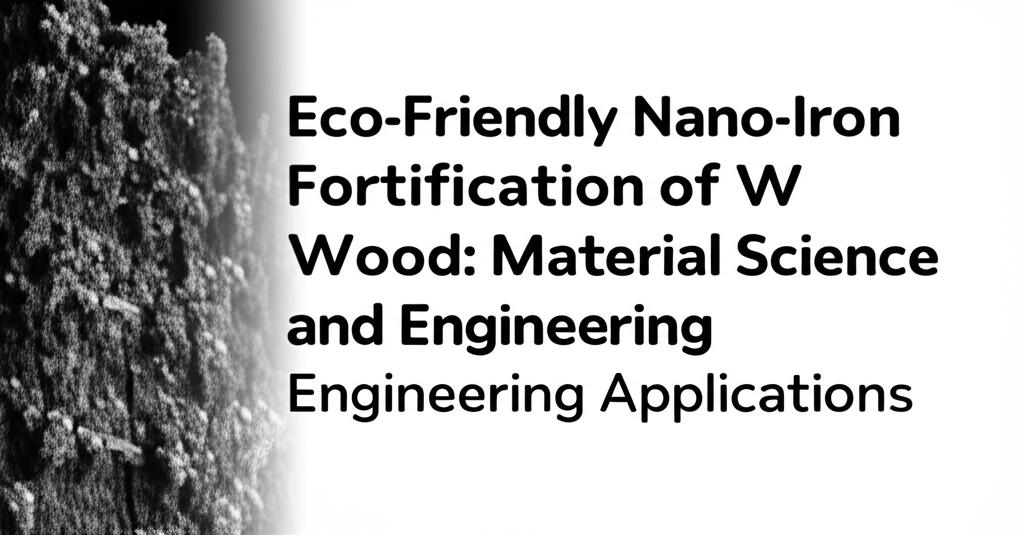Wood, a cornerstone of construction and manufacturing, is undergoing a transformative enhancement through the application of nano-iron fortification. This innovative approach addresses wood's inherent vulnerabilities, such as susceptibility to decay, insects, and dimensional instability, by leveraging the unique properties of iron nanoparticles. The integration of these nanoparticles into the wood's cellular structure promises a new era of high-performance, eco-friendly wood-based materials.
Material Science: Strengthening Wood at the NanoscaleThe core principle behind nano-iron fortification lies in introducing iron-based minerals, often in the form of iron oxides like ferrihydrite, at the nanoscale into the wood's cell walls. Ferrihydrite, a mineral commonly found in soil and water, can be synthesized through a simple and cost-effective chemical reaction, for example, by mixing ferric nitrate with potassium hydroxide.
This process allows the nanoparticles to penetrate deep into the wood's porous structure, reinforcing the individual cell walls. This cellular-level enhancement leads to significant improvements in the material's mechanical properties. Research has demonstrated that this treatment can dramatically increase wood's stiffness and hardness. For instance, studies have shown an increase in stiffness by up to 260.5% and a 127% improvement in hardness. This reinforcement occurs without substantially increasing the wood's weight, a crucial factor for many applications.
Advanced imaging techniques like atomic force microscopy (AFM) and nanoindentation are employed to analyze the treated wood. These methods allow scientists to observe the changes in elasticity and stickiness at a microscopic level, confirming how the mineral additions fortify the wood's internal structure. While the internal structure becomes more durable, the wood's overall macroscopic mechanical behavior, such as how it bends or breaks, may remain largely unchanged. This is thought to be due to the treatment potentially weakening the connections between individual wood cells, even as the cells themselves are strengthened.
Eco-Friendly AdvantagesA significant driver for the development of nano-iron wood fortification is its eco-friendly profile. Wood itself is a renewable and abundant resource, with billions of tons produced globally each year. Enhancing its durability and lifespan through non-toxic means aligns with global sustainability goals.
Traditional wood preservatives often involve chemicals that can pose environmental and health risks. Nano-iron, specifically nanocrystalline iron oxyhydroxide (ferrihydrite), is considered a safe and naturally occurring mineral. This approach offers a greener alternative, reducing the reliance on potentially harmful substances. Furthermore, because the iron nanoparticles are non-toxic, the treated wood should not pose an environmental threat when it is eventually discarded or recycled. This contributes to reducing carbon emissions and construction waste.
Engineering Applications: Expanding Wood's PotentialThe enhanced properties of nano-iron fortified wood open up a wide range of engineering applications. The increased strength and durability make it a viable candidate to replace or supplement traditional construction materials like steel and concrete in various structural applications.
Potential uses include:
- Construction: For elements in tall buildings, bridges, and other infrastructure projects where strength and lightness are advantageous.
- Furniture and Flooring: Offering increased resistance to wear, dents, and scratches, prolonging the lifespan of these products.
- Outdoor Structures: Enhanced resistance to weathering, fungi, mold, and UV degradation can significantly extend the service life of wood used in decks, fences, and railway sleepers.
By improving wood's natural properties in an environmentally conscious and cost-effective manner, nano-iron fortification is paving the way for a new generation of bio-based materials. This technology not only enhances the performance of wood but also contributes to a more sustainable built environment by utilizing renewable resources and reducing the carbon footprint associated with traditional construction materials.
Future OutlookThe field of nano-iron wood fortification is an active area of research and development. While current findings are promising, ongoing efforts are focused on optimizing treatment processes, understanding long-term performance characteristics, and scaling up production for commercial viability. The continued advancement in this area holds the potential to revolutionize the wood industry and contribute significantly to sustainable construction and material science.

